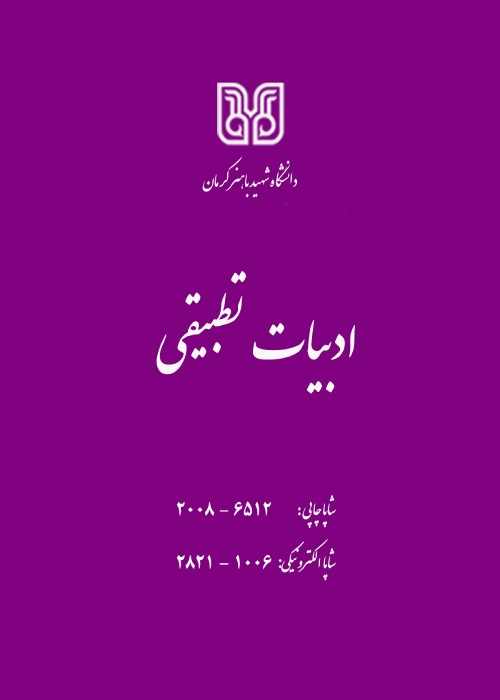A Comparative Study of Ten Little Indians and The Alphabet of Death from the Perspective of Criminal Psychology
Agatha Christie (1890-1976), as one of the most prominent writers of crime fiction genre, has created many works that can be examined from the perspective of criminal psychology and criminology. One of her most difficult and complicated novels, in terms of plot, is the Ten Little Indians, which was originally published in 1939. This novel, like many other novels of Christie, raises this question that “Who is the murderer?” and with focalizing this question/suspension Christie keeps her audience attracted to story from the beginning to the end. The novel narrates the life of a murderer who invites his victims to a ceremony but secretly kills them. His victims have one experience in common: a murder. The central killer of this novel chooses his victims from characters who can be classified under the gray category. They have committed crimes in the past and due to their crimes, victims are left behind, yet these criminals have not been punished. Now, all these criminals are called as ordinary people on a mission outside the city’ they are going to be be punished though none of them knows what awaits them. On the other side of this comparative study is the Iranian novel The Alphabet of Death, written by Mehrdad Morad and published in 2017. In this novel, Morad, with a similar style to Christie, put this question in the core of his plot: "who is the murderer?" The Alphabet of Death unfolds the story of several detectives who work day and night to find a serial killer, who lives in the shadows. His victims, like the victims of Christie's novel, are criminals and have committed various crimes.
This study has used a descriptive-analytical method, for which archival studies have been conducted, especially through the perspective of criminal psychology. In this research, and with close archival reading, the researchers attempted to answer the following questions: What are the characteristics of the murders in these novels? What factor or factors made them a criminal? How does victimization affect a person's delinquency?
In both novels, there is a serial murderer who chooses his victims among the villains and criminals. Yet they have different reasons for killing and to execute it. As Raymaund Gassin classifies it, crimes are divided into two categories: deception-oriented and violence-oriented. Judge Wargrave’s, Christie’s villain, crime falls into the category of phosphoric and deceptive crimes, because his delicacy and his attention to details allows him to commit murders in an unpredictable and flawless manner. Also, he takes action for each person according to their personality traits, which shows his great intelligence, genius, and using the power of reason. As a result of his creative plans, no one suspects him, and if it was not for the found letter, no one would have known the silent murders of those ten people on the island. On the other hand, in The Alphabet of Death, Khosrow Kouhyar's crime is in the category of calcium crimes and is carried out with violence. He carries out all his murders with physical force and uses weapons. He is eventually arrested because of his not-so-conscious plans and because of the smartness of the novel’s detective. The killers of both stories, despite their differences, have commonalities in neutralizers. They both are aware of their vicious acts and violating the law, but by making excuses, they continue committing murders. They do not regret to become notorious or to be called a serial killer, as they think their killings are justified because their victims deserve death. As mentioned above, despite the similarities between both killers, in etiology of crime, their contradictions become apparent. Judge Wargrave suffers from an antisocial and slightly narcissistic personality disorder, which is due to the violent nature he had experienced since his childhood. People with this type of personality think they have to seek justice in the world. They might attempt killing several offenders in order to establish justice in the world. At the end of the novel, Wargrave commits suicide to complete this masterpiece of art. His behavior is a perfect example of the behavior of an untreated patient who has an easy access to social facilities and that put them in trustworthy position and they easily can harm individuals. He did not have a partner to help him to reach his goals, until he needed someone to be a part of his own dramatic murder, he chose Armstrong. On the other hand, Khosrow Koohyar is not sick. He is a victim himself. A person who loses the ability to come to terms with the truth following a criminal incident. Because of not going through a mourning period and being instilled in a period of anger, he engages in revengeful behaviors. Yet, he shows some traces of thoughtfulness: he chooses a partner and adopts an identity of a dead person and hides in some places. But in the end, all his plans are revealed. It could be said that his only goal is to punish the villains and to prevent their criminal acts. He acts completely emotionally. In contrast to Wargrave, he is not aware of other aspects of his plans. Both stories are written in such a way that readers follow them with curiosity from the beginning to the very end. In this process many people are under suspicion. Yet. there are significant differences between the two texts as well. Agatha Christie's work focuses on characterization; she delicately portrays the killers as well as the central character. Her attention to psychological matters in characterization, the use of appropriate suspensions, accuracy in the characters' criminal behavior, and apropos resolution in the story, has distinguished her from the other writers in this genre. One of the points that makes this novel distinct from the other works of Christie is the absence of a detective and that the murder is solved by the hands of the main killer. On the other hand, Mehrdad Morad's novel can be called a plot-oriented work. A work that accompanies the audience with its story and does not provide accurate information about the characters. What attracts attention in this novel is the presence of several detectives. Although the absence of a detective in Agatha Christie's novel does not damage the essence of the story, it can be boldly said that Mehrdad Morad's story depends on the presence of detectives and they play the main role. One of the features of this novel is gripping story line, the appropriate complications, and creating enough drama, which is less visible in Christie's work. Ultimately, it is not farsighted to say that The Alphabet of Death is influenced by Agatha Christie. This can be seen in the general form of the narrative, which is looking for the killer. Also, the name of the work reminds us of the Christie’s novel A, B, C Murders, in which the killer finds his victims in alphabetical order, and this feature is also seen in the murderer's character of Morad's work. What distinguishes his novel from the Ten Little Indians is his attention to the progression of the story through cause-and-effect relationships and minimal focus on the characters in the story.
In The Ten Little Indians and The Alphabet of Death, some serial killers secretly choose their victims and create ambiguity for other characters in the story. The similarity between the two characters is that they think to be rightful. According to Matza and Sykes' theories on the neutralization of crime, they use reason and excuses as neutralizers in their consciences to remove the sense of remorse and achieve a criminal purpose by justifying themselves. But the difference is that the character of the murderer, in Morad's novel, is one day traumatized by a criminal, and also with the loss of his wife, he decides to kill the criminals, which is the result of his grief crisis. The murderer in Christie's novel committs the crimes as a result of psychological factors and due to the existence of a mental disorder in him which is revealed at the end of the novel. Criminological perspectives such as "neutralization techniques," which are based on the perpetrator's wisdom, fit well with the actions of the main characters in both novels. The five techniques that criminals use in their minds before committing the crime to justify the criminal act in their mind and to commit it as their inalienable right have been examined in this article. Also, the theory of "routine activity", which is based on the convergence of three factors in the occurrence of the crime, is analyzed in these crime novels and examples of these convergences and heterogeneity are observed in the mentioned works.
- حق عضویت دریافتی صرف حمایت از نشریات عضو و نگهداری، تکمیل و توسعه مگیران میشود.
- پرداخت حق اشتراک و دانلود مقالات اجازه بازنشر آن در سایر رسانههای چاپی و دیجیتال را به کاربر نمیدهد.



